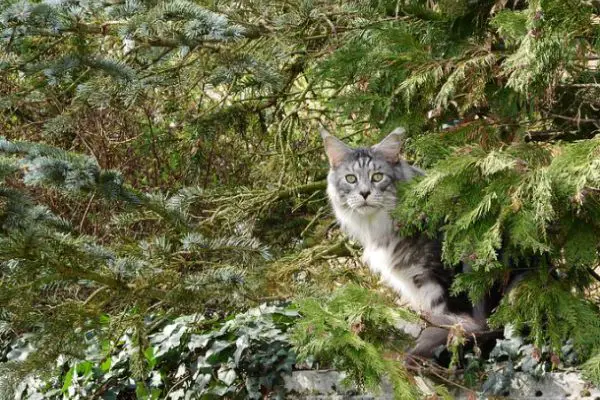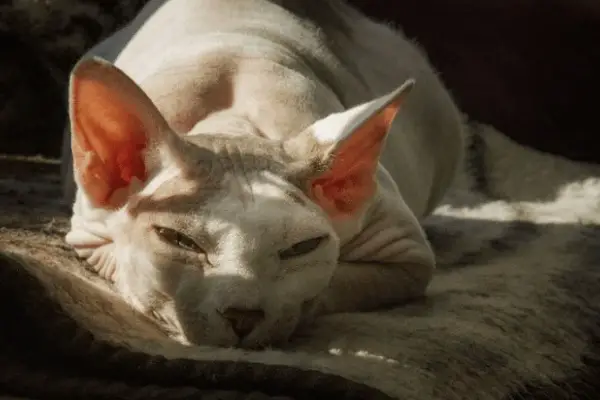Where Do Wild Cats Live (10 Places Wild Cats Live)

The question of where do wild cats live will be discussed all throughout this post.
Wildcats are typically gray-brown in color, with bushy tails and a distinct pattern of black stripes that run the length of their bodies. Their fur is short and silky.
We will be discussing different places wild cats live and differences between wild cats and domestic cats.
Where Do Wild Cats Live
Wild cats primarily live in broad-leaved and mixed forests, woods, scrubland, riparian forest, along sea coasts, and they also inhabit desert regions and are restricted to waterways and mountainous area.
Some people mistake feral cats for wild cats, but both are not the same, even though both can end up living in the same place.
What are wild cats
Wild cats are cats that are born in the woods, forests, or tiny shrubs and have had little or no interaction with people throughout their life history.
Now you understand what wild cats are let’s look at some part of the world where wild cats live.
Where do wild cats live in the world?
Wild cats may be found in various parts of the world, including southern Asia, continental Europe, and Africa’s Savannah areas.
These areas of the world are the most common areas of the world where you can find wild cats.
Common places wild cats live
These places where wild cats live can simply be called or known as habitats.
Therefore, here are some common places where wild cats live:
1. Small caves
Because of the abundance of prey, most wild cats establish territories in caves, and they eventually make these caves their resting and hiding places.
Wild cats prefer the tranquil and cool atmosphere that caves provide, and they already know that these caverns are protected from human intrusion.
Caves are full of mice, which are a key prey for wild cats, and if a wild cat discovers a cave with plenty of prey, it will take it over.
Taking over the cave entails settling down and starting a family.
2. Under falling trees
One of the most common places for wild cats to have kittens and reside is under fallen trees.
These fallen trees are always cool, tranquil, and out of reach of humans, making them an ideal location for a wild cat to have kittens and survive.
Most fallen trees have high roots that provide a safe haven for these wild cats, as well as holes that house prey for cats.
However, the cat may have to fight other small animals for territory, and if the cat wins, the fallen tree becomes the cat’s domain, where kittens can be born.
There are a lot of fallen trees that wild cats use as their home in the forest.
3. Small bushes
Wild cats that have survived for the time being till they can have their own children are no longer strangers in their surroundings.
Some wild cats move a lot, especially at night, and they are familiar with all the safe bushes in the area.
They may simply give birth in any little bush that she believes is secure for her babies.
These shrubs are ideal hunting grounds for wild cats, and we know that cats prefer to dwell near better food sources.
If you find kittens alone on the road, remember that they were born in the little shrubs nearby.
4. Close to woods
Most woodlands provide wild cats with shelter, food, and a noise-free environment, which will entice them to join a colony.
Most forests, however, are a haven for wild creatures, which these wild cats are aware of, and most wild cats have their kittens near these woods rather than inside the woods.
The majority of feral cats that dwell in the woods will eventually mature into wild cats, honing their hunting abilities over time.
The wood is an excellent spot to look for a lost cat since it contains a variety of exciting prey that will keep the cat occupied all night.
5. Desert regions
Wild cats can be seen in lower desert regions with small grass growing around them.
This low desert regions house more prey for wild cats and house low numbers of predators making them a perfect site for wild cats.
6. Broad-leaved and mixed forests
These areas look much like the woods but houses fewer predators that hunt wild cats.
You will see small birds, and rodents in these areas which make up food for wild cats.
7. Mountains
Wild cats live in low places or areas of the mountains and these areas contain shrubs and trees that provide shades for them.
Remember a mountain is a raised section of the Earth’s crust with steep sides and exposed bedrock.
A mountain is bigger than a hill and has a smaller peak area than a plateau, rising at least 300 meters (1000 feet) above the surrounding plain.
These heights make it easier for wild cats to see predators coming and also serves as a hunting grounds.
8. Hills
Hills are landforms that rise above the surrounding landscape and have relatively limited peaks, but are smaller than mountains in general.
The height of hills makes them a perfect hunting and live areas for wild cats.
These wild cats live and give birth to their kittens in the hills, they also teach their kittens how to hunt in these hills.
9. Valleys
A valley is a long, low plain that runs between hills or mountains and usually has a river or stream running through it from one end to the other.
The majority of valleys are produced by rivers or streams eroding the ground surface over a lengthy period of time.
These areas make a perfect home for wild cats as they can find lots of prey to feed on.
10. Restricted or open waterways
Restricted or open waterways are also a perfect hunting and living area for wild cats.
There are lots of rodents and small birds to be hunted by wild cats in open waterways.
Where do wild cats sleep
Wild cats sleep in a variety of places which includes broad-leaved and mixed forests, woods, scrubland, riparian forest, along sea coasts, desert regions and are restricted to waterways and mountainous area.
What do wild cats eat?
Wild cats mostly feed on small birds, lizards, snakes, large insects, moles, shrews, rabbit, mice and rats as these small rodents are found in places where wild cats live.
These set of small animals are the reasons why wild cats survive in the wild and also the reasons why wild cats live shorter than domestic cat.
Do wild cats eat fish
Yes, wild cats hunt and eat fresh water fish if they live in areas where they have access to running water.
Wild cats search for water to drink and when they found any they can hunt and live close to the water.
Differences between wild cats and domestic cats
Here are some common differences between wild cats and domestic cats:
| Wildcats | Domestic cats |
| Wildcats live shorter (5-9 years) | Domestic cats live longer (12-15 years) |
| Wildcats are independent | Domestic cats depends on their owners |
| Wildcats can survive extreme weather | Domestic cats are weather sensitive |
| Wildcats are resistance to certain illness | Domestic cats are prone to lots of illness |
| Wildcats are considerably bigger and stronger | Domestic cats are small and less strong |
| Wildcats can survive parasite infestations longer. | Domestic cats depends on their owners to survive parasite infestations. |
| Wildcats can withstand much stress | Domestic cats are prone to stress and can become aggressive |





![How Do Cats Get Leukemia [9 Top Ways] How Do Cats Get Leukemia](https://petcreeks.com/wp-content/uploads/2023/04/How-Do-Cats-Get-Leukemia-768x555.jpg)
